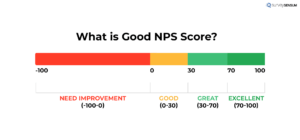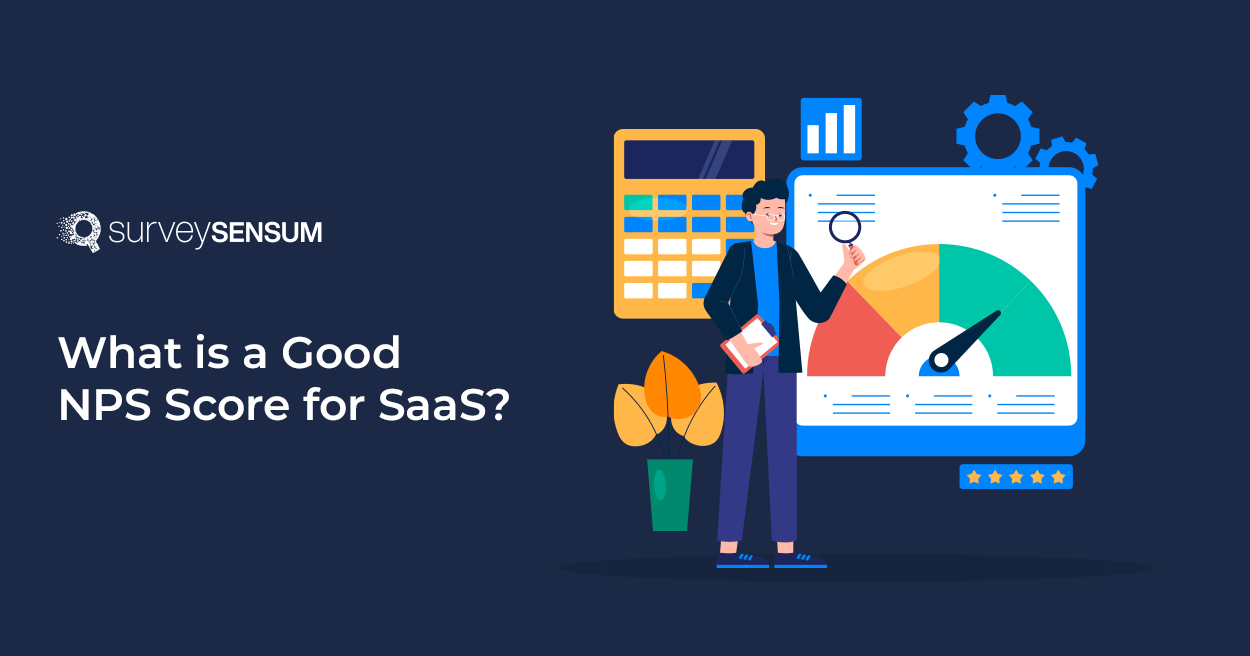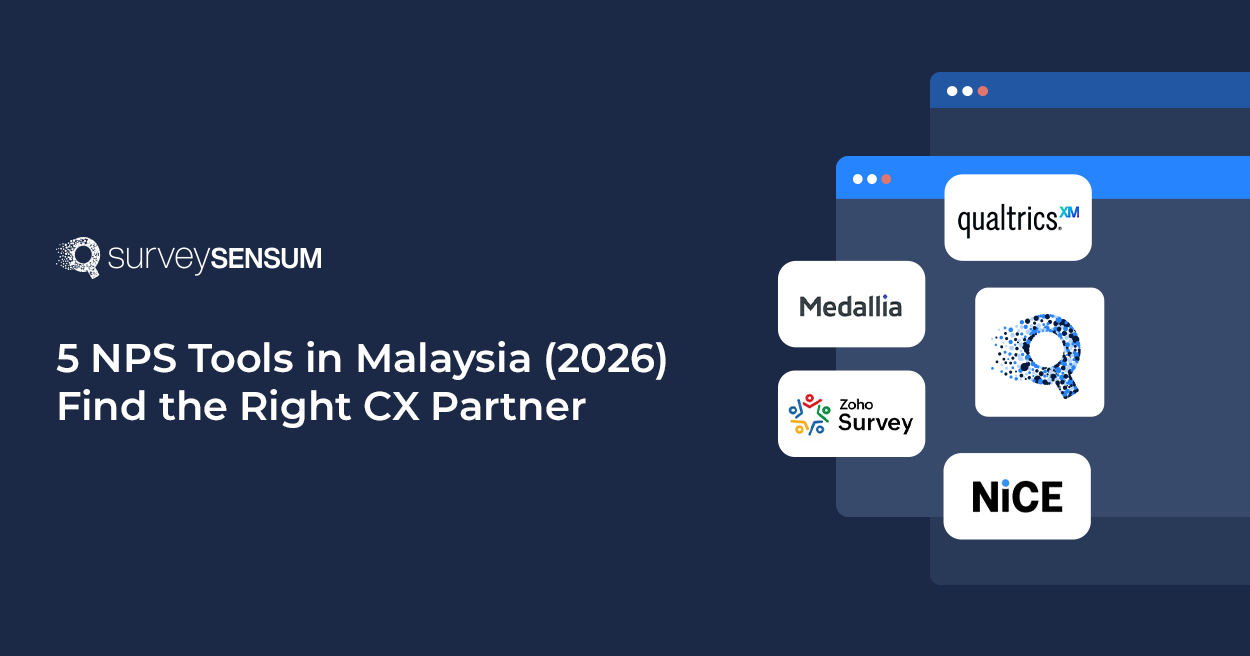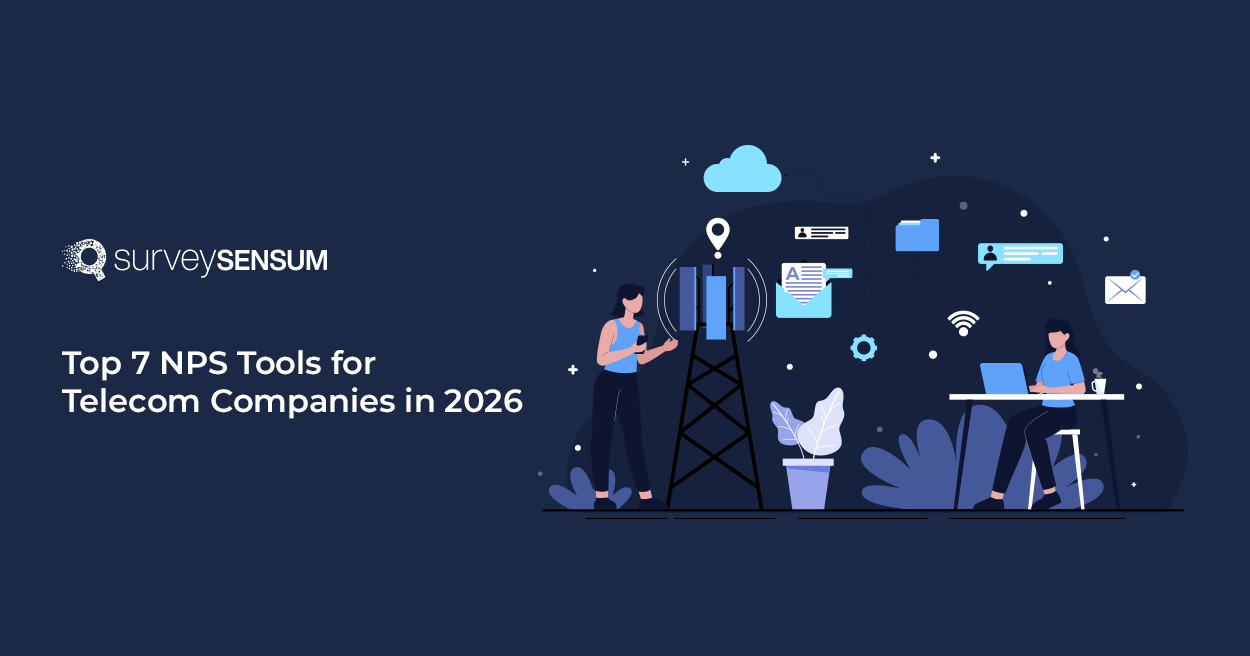

Net Promoter Score scores serve a purpose beyond measuring customer satisfaction; they offer cues for upselling and cross-selling opportunities in the saas industry.
How?
When customers give high NPS scores, it signifies their satisfaction and loyalty. This means they’re likely interested in exploring more of your company’s offerings.
This, in turn, helps you plan your strategy to strengthen your relationship with existing customers, potentially boosting revenue while enhancing customer experiences.
Thus, NPS proves to be a versatile metric that gives insights into customers’ expectations and experiences. It also assists in gauging the effectiveness of building strong connections.
But, why is NPS benchmarking important for SaaS, and what is a good NPS score for the SaaS industry? let’s find out.
Let’s begin with the NPS calculation.
How to Calculate NPS Score?

Calculating NPS is really simple. To calculate the score, you need to create and send a short NPS survey with a 5 or 11-pointer scale question with the best NPS software tool. Your customers will rate their score on a scale from 0 to 10 about their likelihood of recommending your SaaS product to others. Their answers segregate them into three groups:
- Promoters aka your fans (9-10)
- Passives aka your neutrals (7-8), and
- Detractors aka your critics (0-6)
When you subtract the percentage of Detractors from the percentage of Promoters, you get your NPS score.
Calculate your NPS Score for FREE
Now you must be thinking about
→ What is a good NPS score for SaaS?
→ How to know if the score is a good NPS score or not? Is there any need to conduct SaaS NPS Benchmarking?
→ What are the top NPS scores of SaaS businesses?
→ How to improve your B2B SaaS NPS scores?
Well, we’ll be talking about these – so, continue reading.
Why is NPS Important for SaaS Companies?
Net Promoter Score is particularly important for SaaS companies for several key reasons:
1. Customer Retention: SaaS companies rely heavily on subscription-based models. High SaaS customer retention rates are crucial for sustained revenue. NPS helps identify promoters who are likely to renew subscriptions and detractors who might churn, enabling proactive retention strategies.
2. Customer Loyalty: Loyal customers are essential for the success of SaaS companies. NPS provides a direct measure of customer loyalty, helping companies understand the proportion of their customer base that is genuinely satisfied and likely to continue using their services.
3. Feedback and Improvement: NPS surveys include follow-up questions asking customers to explain their scores. This qualitative feedback is invaluable for understanding customer pain points, guiding product development, and improving the overall customer experience.
4. Referrals and Organic Growth: Promoters are more likely to refer others, driving organic growth through word-of-mouth. In the competitive SaaS market, positive referrals can significantly reduce customer acquisition costs and accelerate growth.
What is a Good NPS Score for the SaaS Industry?

Now that you’ve got your NPS score it’s time to know whether it’s a good score or not.
If your NPS is
- Between 0 and 30 then it’s a solid score – indicating progress in customer satisfaction.
- In the 30 to 70 range then it’s more than good – it reflects excellence in your approach.
- Above 70 then it’s a commendable achievement – showcasing exceptional customer experience.
To get a good NPS score you also need to design and launch the NPS survey at the right touchpoint in the customer journey. But don’t worry, you don’t need to spend hours figuring out the process. Just sign up to SurveySensum today and let the robust NPS software take care of all your survey needs!
Though, truth be told, hitting that mark is a bit like hitting a home run – not everyone does it. So if you have got a score let’s say 45, then is it considered a good NPS score? Let’s find it out here.
How to Determine if Your NPS Score is Good or Not?
When it comes to determining what is a good NPS score, there are several key steps you can take to gain meaningful insights.
1. Benchmark NPS Score by Industry
Start by researching NPS benchmarks specific to your industry. Different industries have varying standards for what constitutes a good NPS.
That’s why comparing your NPS against industry benchmarks can gauge whether your score is competitive and aligned with customer expectations in your field.
A study on NPS benchmarks by industry, revealed the average NPS score by different industries. For example, according to B2B SaaS NPS benchmarks a score above 40 is considered good.


*Source: Retently 2024 NPS Benchmarks for B2B & B2C
2. Benchmark Against Your Own Data
A vital step in assessing your NPS score is comparing it to your previous scores. Tracking the trend of your NPS over time can reveal improvements or declines in customer satisfaction.
If your NPS is consistently increasing, it suggests your efforts are positively impacting customer loyalty. Conversely, a declining trend indicates the need for closer examination and changes in your strategies.
3. Segment the Score by Channel
It’s essential to analyze NPS scores by different customer interaction channels. Whether it’s through email, website, or in-person interactions, there’s a possibility of customers having different experiences.
For instance, WhatsApp surveys give higher survey response rates in India however, when you call then they get irritated which leads to a low NPS response rate.
That’s why segregating scores by channel helps you identify which touchpoints are excelling and which ones require enhancement. This targeted approach enables you to focus your resources where they’re most needed.
4. Regional Benchmarking
Customer expectations and preferences differ across various regions. By comparing your NPS scores across different geographical areas, you can tailor your strategies to better suit the specific needs of each region.
For example, in the United States, survey participants can rate your survey either remarkably high, such as 9 or 10, or exceptionally low, like 2 or 3. Conversely, when conducting an NPS survey in Indonesia, you’re likely to receive more scores of 7, 8, or 9 as they’re much more generous.
This is how you can embrace SaaS NPS benchmarking. By doing this, you can gain the required insights to enhance customer loyalty and drive growth. Also, it enables you to evaluate your performance against established industry standards.
Only creating NPS surveys is not enough, the endgame is to extract valuable insights and create action plans to boost your business performance and revenue. So, sign up today with SurveySensum and take advantage of the robust NPS software and all its advanced NPS features and capabilities.
Let’s discover the NPS score of the top 38 SaaS companies.
NPS Benchmark Scores of Top 38 SaaS Companies
Here are the NPS scores of the top 38 SaaS companies:
| S. No. | Company | NPS Score |
| 1 | Nutanix NPS score | 92 |
| 2 | NetMotion NPS score | 91 |
| 3 | Cohesity NPS score | 90 |
| 4 | Druva NPS score | 89 |
| 5 | AppDynamics NPS score | 87 |
| 6 | Qumulo NPS score | 85 |
| 7 | SignNow NPS score | 73 |
| 8 | Veeam NPS score | 73 |
| 9 | Zoom NPS score | 72 |
| 10 | Snowflake NPS score | 71 |
| 11 | Square NPS score | 70 |
| 12 | Cleo NPS score | 70 |
| 13 | Netflix NPS score | 67 |
| 14 | DocuSign NPS score | 66 |
| 15 | Paypal NPS score | 65 |
| 16 | CustomerGauge NPS score | 60 |
| 17 | Google NPS score | 58 |
| 18 | Slack NPS score | 55 |
| 19 | Dropbox NPS score | 54 |
| 20 | Intuit NPS score | 52 |
| 21 | Hulu NPS score | 51 |
| 22 | YouTube NPS score | 49 |
| 23 | Instagram NPS score | 49 |
| 24 | Atlassian NPS score | 48 |
| 25 | Shopify NPS score | 43 |
| 26 | Idera NPS score | 42 |
| 27 | Uber NPS score | 37 |
| 28 | eBay NPS score | 36 |
| 29 | Adobe NPS score | 33 |
| 30 | Twilio NPS score | 33 |
| 31 | Microsoft NPS score | 31 |
| 32 | Twitch NPS score | 30 |
| 33 | Yahoo NPS score | 30 |
| 34 | Mailchimp NPS score | 28 |
| 35 | LinkedIn NPS score | 21 |
| 36 | SalesForce NPS score | 20 |
| 37 | Facebook NPS score | 19 |
| 38 | Lyft NPS score | 9 |
*Source: CustomerGauge
Now let’s talk about the NPS score of the top 3 SaaS companies.
3 SaaS Companies Using NPS
To gain an in-depth understanding of the importance of NPS for SaaS companies, let’s take a look at the top 3 SaaS companies and how they are using NPS strategies to improve customer loyalty and retention.
1. Amazon
Launched in 2006, Amazon provides on-demand cloud computing platforms and APIs to individuals, companies, and governments. Launched in 2006, Amazon employs 1,541,000 employees and serves about 300 million active users. The NPS score of Amazon is 62 which is well above the average SaaS NPS score of 40.
2. Google
Google is a multinational technology company specializing in Internet-related services and products. Google employs 182,502 employees and serves about 1.5 billion individuals. The NPS score of Google is 50 which is well above the SaaS industry average NPS.
3. Netflix
Netflix is a leading streaming service provider that offers a wide variety of award-winning TV shows, movies, anime, documentaries, and more on thousands of internet-connected devices. Founded in 1997, Netflix employs 13,000 employees and has about 269.6 million paid subscribers. The NPS score of Netflix is 67 which is well above average SaaS NPS score of 40.
Let’s now understand how to improve NPS score in the SaaS industry.
How to Improve NPS Score in SaaS?
Here is how you can improve your NPS score in the SaaS world.
- Prioritize Customer Support: Swiftly address queries and concerns to show commitment to customer success, fostering loyalty and positive word-of-mouth.
- Enhance Product Usability: Ensure your SaaS product is user-friendly with simple interfaces and easy navigation, contributing to positive user experiences.
- Personalize User Experiences: Tailor interactions based on individual preferences, making customers feel valued and engaged with your product.
- Close the Feedback Loop: Listen actively to customer feedback and take action to address their suggestions, demonstrating your dedication to meeting their needs.
- Offer Incentives for Referrals: Encourage satisfied customers to refer others by providing incentives or rewards, leveraging their enthusiasm to expand your customer base.
- Continuous Improvement: Regularly assess NPS scores, analyze NPS feedback, and adapt strategies with customer expectations to deliver the best customer experience.
And The Bottom Line
Now you know what is a good NPS score for SaaS.
A good NPS score isn’t just a mere number; it reflects how content your customers are and shows how well your business is doing. It’s more about having real supporters of your product.
In today’s digital world, where customer opinions matter, a good NPS score can guide your business amid competition, helping you grow and build strong customer relationships.
That’s why create NPS surveys tailored to your SaaS business by exploring SurveySensum. It’s an exceptional NPS tool that offers multiple survey templates and robust features to analyze the gathered data.
Create NPS Surveys for your SaaS Business With SurveySensum
Frequently Asked Questions
A good NPS for B2B SaaS falls within the range of 30 to 50. However, this can vary depending on industry benchmarks and specific customer expectations. Higher scores indicate a higher likelihood of customers recommending the product or service to others.
A decent Net Promoter Score generally ranges between 0 to 30. While scores in this range suggest that there are satisfied customers who may recommend the product or service, there is still room for improvement in customer satisfaction and loyalty efforts.
An NPS score of 25 can be considered good, as it indicates that there are more promoters than detractors. However, the interpretation of the score can vary based on industry benchmarks and specific business goals.
The NPS score of Amazon is 73.

















